Are tiny flies buzzing around your kitchen, especially near your fruit bowl or trash can? You’ve likely got fruit flies! Don’t worry, these common kitchen pests are more of a nuisance than a major problem, and thankfully, getting rid of them doesn’t require harsh chemicals or expensive solutions. In fact, you can probably find everything you need to create effective fruit fly traps right in your pantry.
Recently, we experienced a fruit fly invasion in our own home – a rare occurrence for us. This unexpected situation became the perfect opportunity to put various fruit fly elimination methods to the test. We meticulously experimented with 7 different approaches, taking detailed notes (yes, even spreadsheets were involved!). Today, I’m sharing the most effective homemade fruit fly traps and exactly how to make them.
These DIY traps are incredibly simple to assemble using natural, household ingredients. They’re budget-friendly, chemical-free, and extremely easy to make. Plus, if you’re feeling compassionate, some of these traps even offer a humane way to release the captured fruit flies outdoors. We’ll also cover essential tips to prevent fruit fly infestations in the first place, saving you from future swarms.
What Exactly Are Fruit Flies?
Fruit flies are small, winged insects that are strongly attracted to ripe and fermenting fruits and vegetables – their name is quite descriptive! They are also drawn to sugary substances and fermented drinks like beer, wine, and juice. You’ll often find them congregating around fruit bowls, garbage disposals, trash cans, and even sink drains. They’re about the size of a grain of rice and resemble small, tan or brownish houseflies with distinctive red eyes. Fruit flies are most prevalent during the warmer months of summer and late fall when fruits are abundant and ripening.
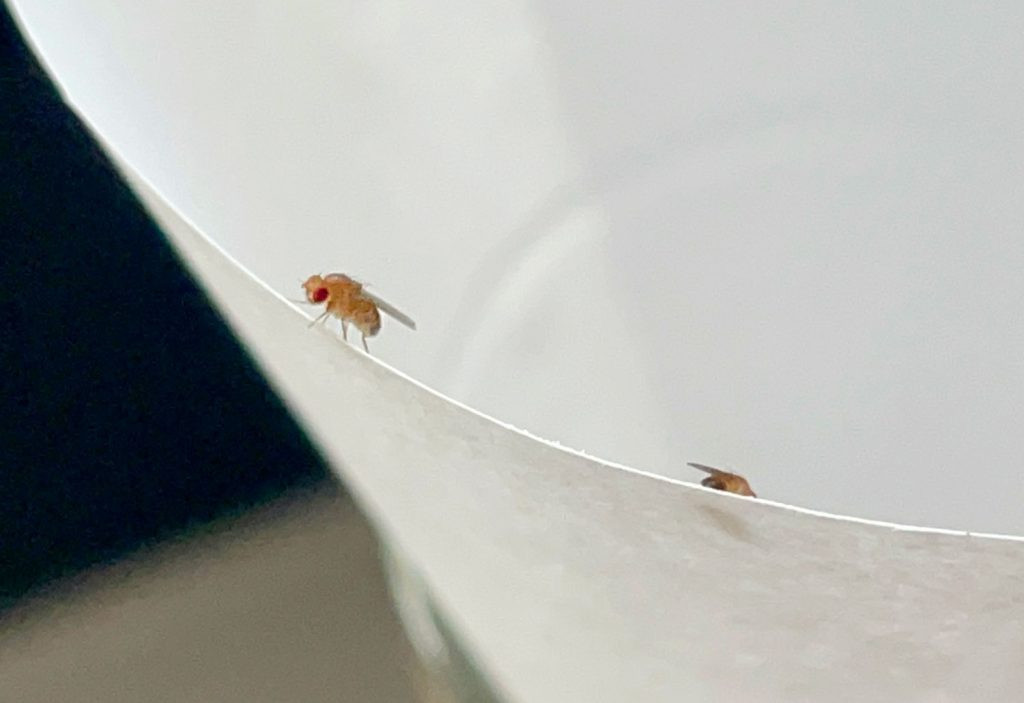 Close Up Of Fruit Fly On Paper Funnel
Close Up Of Fruit Fly On Paper Funnel
A fruit fly problem often begins when a few of these pests sneak into your home on fruits or vegetables from the grocery store. However, female fruit flies are prolific breeders, capable of laying hundreds of eggs in their short lifespan, with eggs hatching in as little as 12 hours. They can mature into adults in just a few days, meaning a small initial infestation can quickly explode into a large swarm. This rapid reproduction cycle is why it’s crucial to get rid of fruit flies as quickly and efficiently as possible.
Fruit Flies vs. Fungus Gnats vs. Drain Flies: Spotting the Difference
Fruit flies are often confused with other tiny flying insects that can infest homes, especially fungus gnats and drain flies. While all are small and annoying, correctly identifying the pest is key to choosing the most effective elimination method. The easiest way to tell them apart is by where you see them and what larger insect they most closely resemble.
- Fruit flies look like miniature flies. They are typically found near fruit bowls, overripe produce, garbage, spills, or any fermenting food sources.
- Drain flies look like tiny, fuzzy moths. As their name suggests, they are usually seen around sinks, drains, and damp areas.
- Fungus gnats look like small mosquitoes. They are commonly found near houseplants, as they breed in damp potting soil.
If you’re uncertain which pest you’re dealing with, try one of the fruit fly traps described below. If it attracts the insects in your home, you can confidently identify them as fruit flies and proceed with targeted elimination strategies.
4 Easy DIY Fruit Fly Traps to Make at Home
Getting rid of fruit flies doesn’t have to be a complicated or expensive endeavor. All you need are a few common household items and a bit of patience. Each of these traps operates on the same principle: lure the fruit flies in and prevent their escape. We tested the following 4 DIY methods and found a clear winner. However, since each method uses ingredients you likely already have, it’s worth trying more than one to see what works best for you. Think of it as a fun little science experiment in your kitchen! Here are the first 4 methods I tested:
- Funnel Trap
- Plastic Wrap Trap
- Dish Soap Trap
- Rotting Fruit Trap
I’ll provide detailed instructions for each method below, along with our verdict on their effectiveness. Keep in mind that some traps work faster than others, and it may take several days to completely eradicate a fruit fly problem, regardless of the technique you choose.
#1: The Simple Paper Funnel Fruit Fly Trap
This trap design uses a paper funnel to guide fruit flies into a container baited with an attractant. The narrow opening at the bottom of the funnel makes it easy for flies to enter but difficult for them to find their way back out.
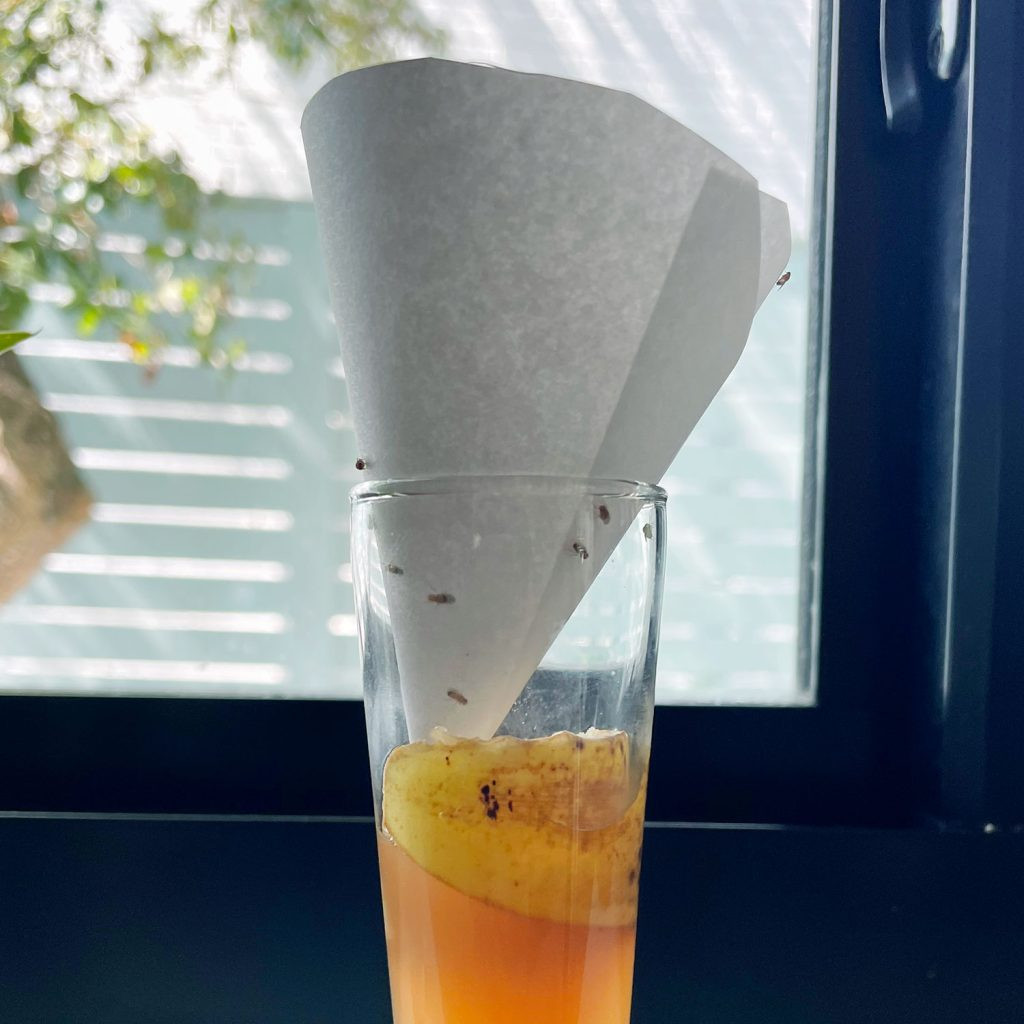 DIY Fruit Fly Trap With Paper Funnel
DIY Fruit Fly Trap With Paper Funnel
Supplies needed:
- Small, clear jar, cup, or container – a narrow opening is preferable
- Piece of paper or cardstock
- Tape
- Scissors
- Apple cider vinegar (ACV)
Instructions:
- Choose your container. Select a small, clear container like a recycled food jar or plastic bottle. A narrow opening will enhance the trap’s effectiveness.
- Add apple cider vinegar. Pour a small amount of apple cider vinegar, old beer, or wine into the bottom of the container. These liquids are potent attractants for fruit flies.
- Make your funnel. Shape a piece of paper or cardstock into a cone with a very small opening at the tip. Secure the cone shape with tape. You can create the small opening by cutting the tip after forming the cone if that’s easier. The opening only needs to be about the size of a grain of rice.
- Set your funnel in place. Position the paper cone inside the opening of your container. You might need to adjust the funnel’s shape so it rests securely on the container’s rim without touching the liquid bait. Ensure the funnel fits snugly against the edges of the opening to prevent flies from escaping through any gaps.
- Optional humane release. To release trapped flies, carefully carry the entire trap outdoors without disturbing the funnel (or the flies will escape!). Remove the funnel outdoors and allow the fruit flies to fly away.
While you can also use a store-bought funnel, the opening at the bottom might be too wide, allowing captured fruit flies to escape more easily. A homemade paper funnel provides a more customized and effective narrow opening.
#2: The Plastic Wrap & Vinegar Fruit Fly Trap
Similar to the funnel trap, this method uses the enticing scent of apple cider vinegar to attract fruit flies. They enter the trap through tiny holes poked in a plastic wrap cover, but then struggle to escape.
Supplies needed:
- Small, clear jar, cup, or container
- Rubber band
- Plastic wrap or a plastic bag
- Toothpick
- Apple cider vinegar (ACV)
Instructions:
The steps for creating this plastic wrap trap are very similar to the funnel trap.
- Choose your container. Find a small, clear jar, cup, or any glass container. Almost any size works, and clarity is helpful for observing the trapped flies, but even an old can will do.
- Add apple cider vinegar. Pour apple cider vinegar into your container. The sweet, fermented scent is irresistible to fruit flies. Old beer or wine also work well, but avoid using regular white vinegar, as it’s not as attractive to them.
- Cover the opening tightly with plastic. Stretch plastic wrap tightly over the container’s opening and secure it firmly with a rubber band. Saran wrap works perfectly, or you can cut a piece from a plastic bag.
- Poke small entry holes. Use a toothpick to carefully poke a few small holes in the plastic wrap. You don’t need many holes, just make sure they are large enough for a fruit fly to squeeze through.
- Optional humane release. To release the trapped flies, carefully take the entire trap outside without removing the plastic wrap (or they will quickly escape!). Once outside, remove the plastic wrap and let them fly away.
Alternatively, you can adapt this technique using a metal jar lid. Use a mason jar or an old food jar with a metal lid. Carefully use a hammer and nail to puncture a small hole in the lid instead of using plastic wrap.
#3: The Simple Dish Soap Fruit Fly Trap
This trap is even simpler than the previous two, as it doesn’t require any paper funnels or plastic wrap covers. Instead, it relies on the principle of surface tension reduction. Note: This method is not designed for humane release, as the soap will coat the flies.
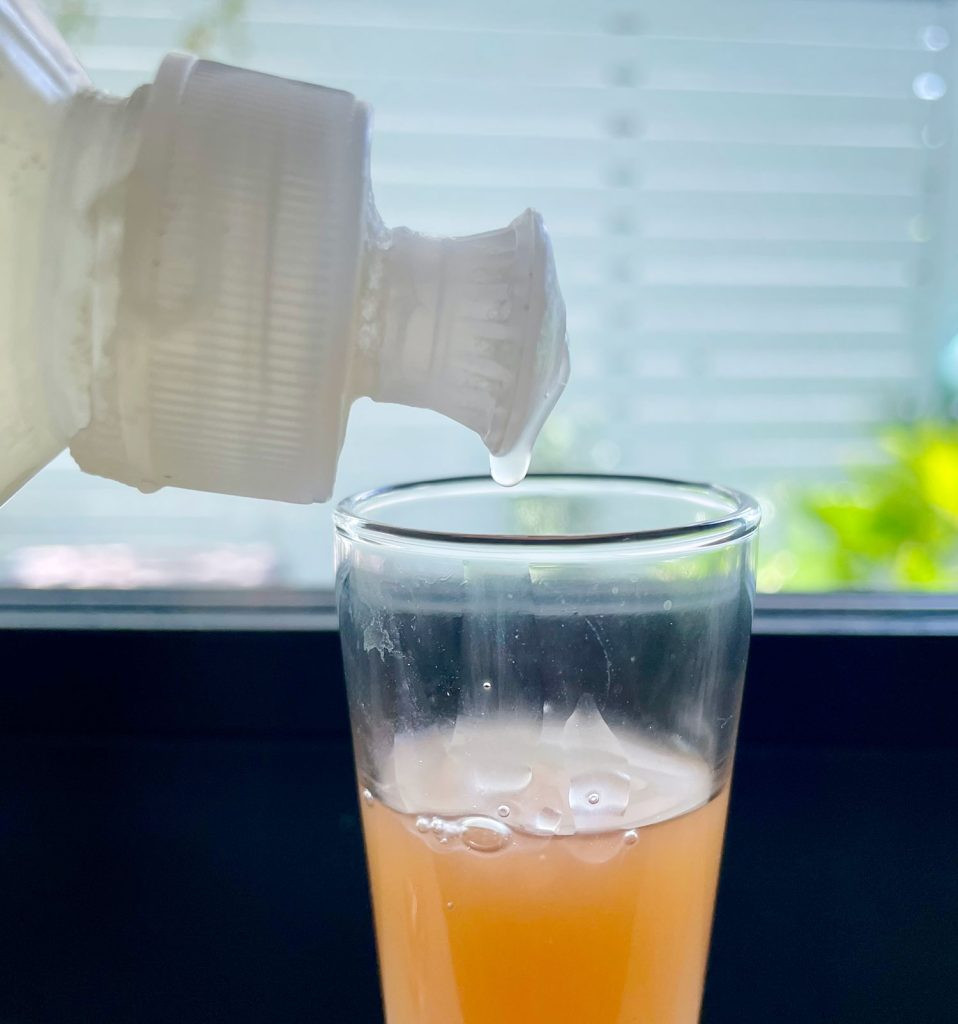 Dripping Dish Soap Into Apple Cider Vinegar For DIY Fruit Fly Trap
Dripping Dish Soap Into Apple Cider Vinegar For DIY Fruit Fly Trap
Supplies needed:
- Small container, bowl, or dish
- Dish soap
- Apple cider vinegar (ACV)
Instructions:
This trap is incredibly easy to assemble:
- Pour apple cider vinegar into a container. Similar to the other traps, fill the bottom of a small container, bowl, or dish with apple cider vinegar. This will act as the primary attractant.
- Add dish soap and gently mix. Squirt several drops of dish soap into the apple cider vinegar. Gently stir or swirl to mix – avoid creating bubbles. The dish soap breaks the surface tension of the vinegar. Fruit flies will be attracted to the scent, land on the surface, and become trapped in the liquid due to the soap.
This dish soap technique can also be combined with the plastic wrap or funnel methods. Simply add a few drops of dish soap to the apple cider vinegar before covering the container with plastic wrap or inserting the paper funnel. This adds an extra trapping mechanism to those designs.
#4: The Decoy Rotting Fruit Trap
We also experimented with traps that replaced apple cider vinegar with what fruit flies arguably love even more: actual rotting fruit!
Supplies needed:
- Small glass jar, cup, or container
- Plastic wrap or paper funnel (depending on your chosen trap mechanism)
- A small piece of overripe fruit, such as a banana peel or apple slice
Instructions:
To create a rotting fruit trap, simply substitute apple cider vinegar with a piece of banana peel, apple slice, peach, or other ripe fruit in either the Plastic Wrap Trap or Funnel Trap methods described above. You can also enhance the effectiveness by adding a piece of fruit to your apple cider vinegar traps as well. Just remember to replace the fruit every day or two to prevent unpleasant odors in your kitchen as the fruit continues to decompose.
The Verdict: Which Fruit Fly Trap Works Best?
As you can see from our experiment photos, we set out 4 different DIY fruit fly traps to compare their performance. The four homemade traps we tested were:
- Plastic Wrap Trap with banana peel
- Funnel Trap with ACV + banana peel
- Plastic Wrap Trap with ACV + dish soap
- Dish Soap Trap with ACV
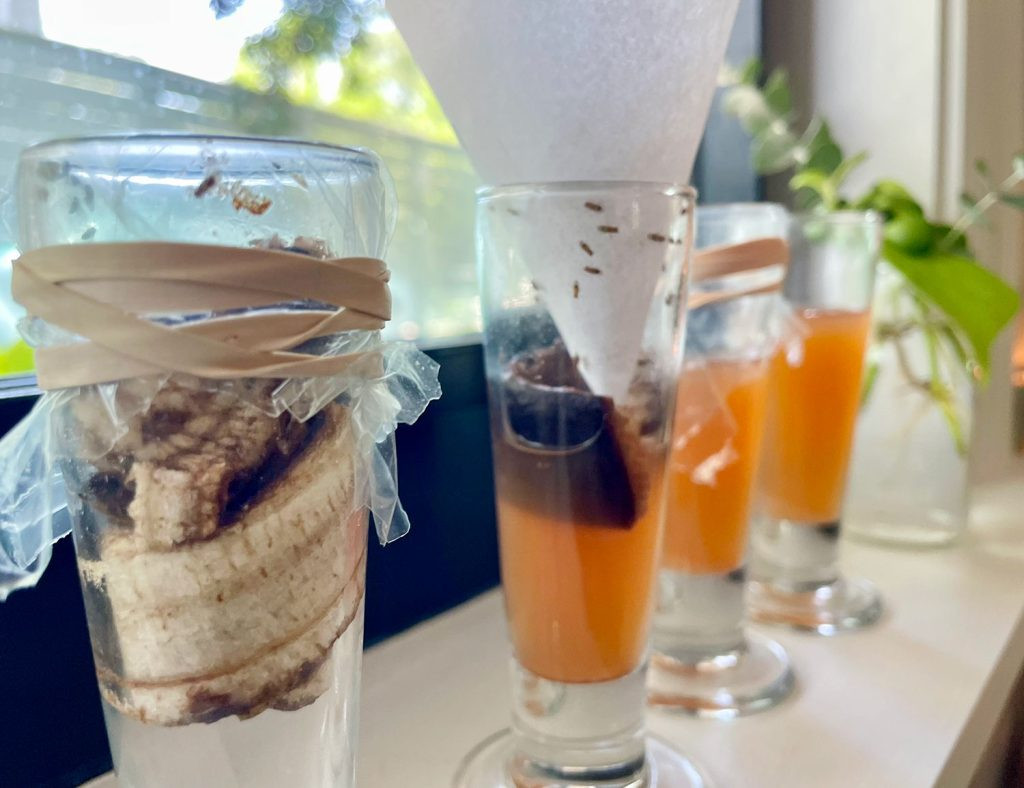 4 DIY Fruit Fly Traps Close Up
4 DIY Fruit Fly Traps Close Up
Our results showed that the type of bait was more crucial than the trap design. Traps using banana peel as bait performed significantly better than those using only apple cider vinegar. Our two Plastic Wrap Traps were almost identical in design, but the one baited with banana peel dramatically outperformed the ACV and soap trap. Perhaps apple cider vinegar is less appealing when there’s real fruit nearby?
Based on our experiment, we recommend adding a piece of fruit to any DIY fruit fly trap you set up for optimal effectiveness! We slightly preferred the plastic wrap trap because it was easier to assemble and less prone to accidental spills. I did knock over the funnel trap once, inadvertently releasing a bunch of flies back into the kitchen – oops!
What’s the Most Enticing Fruit Fly Bait? Let’s Experiment!
Our success with fruit scraps sparked further curiosity. We wanted to determine which type of fruit was the most effective bait. Using the plastic wrap trap design, we tested three readily available fruits: banana peel, apple slices, and a strawberry. We placed each trap side-by-side on our kitchen counter for 24 hours.
Although the banana peel started out quite ripe and fragrant, the fruit flies were ultimately most attracted to the strawberry. The banana peel still caught a good number of flies, but the strawberry’s appeal increased as it ripened further. Interestingly, the apple slices didn’t catch a single fruit fly!
Store-Bought Fruit Fly Traps: A Convenient Alternative
If DIY solutions aren’t working for you, or if you prefer a ready-made option, there are commercially available fruit fly traps you can purchase. These traps generally receive thousands of positive reviews and cost under $20. They might be worth considering if you want a trap that catches a wider variety of flying insects, or if you prefer a more discreet appearance compared to DIY traps.
 Collage of Storebought Fruit Fly Traps
Collage of Storebought Fruit Fly Traps
During our experiment, I also bought a pack of Terro Fruit Fly Traps to compare their performance against our homemade methods. I placed a Terro trap next to our banana and strawberry traps for 24 hours to see which performed best.
Again, our homemade strawberry trap captured the most flies, closely followed by the banana peel trap. The store-bought trap only caught one. HOWEVER…
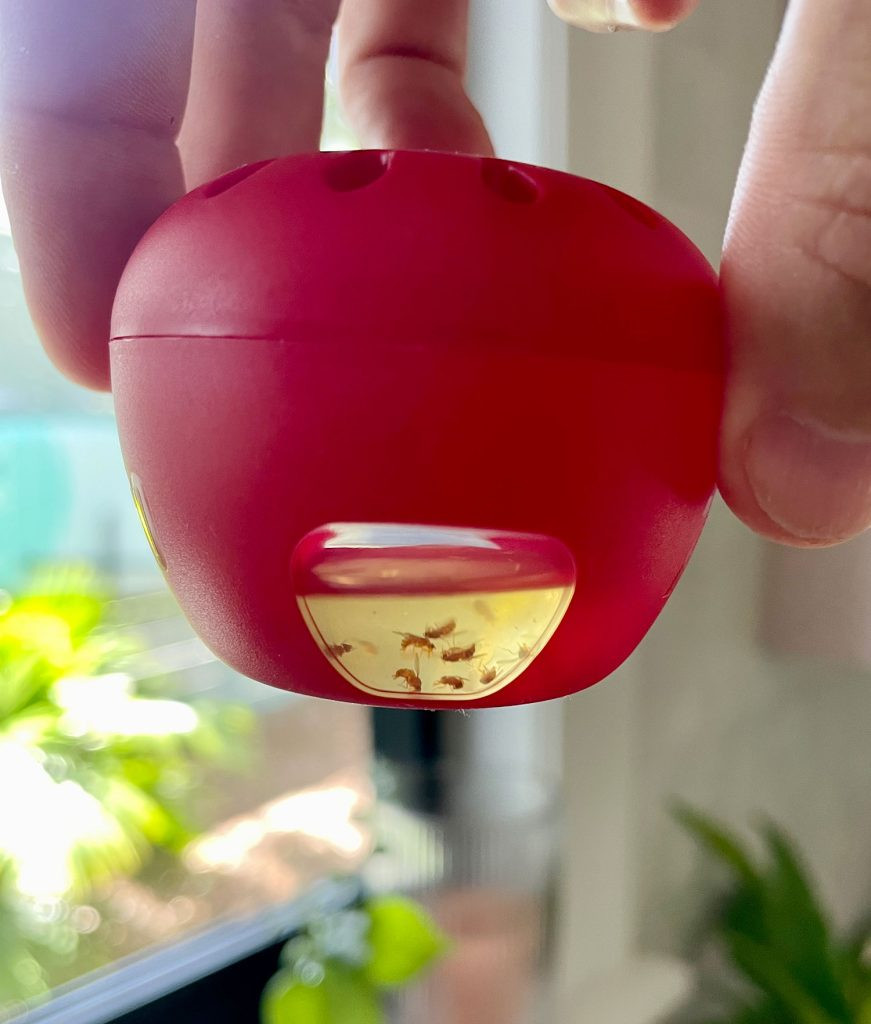 Terro Fruit Fly Trap With Dead Fruit Flies Visible
Terro Fruit Fly Trap With Dead Fruit Flies Visible
To ensure a fair comparison, we discarded our DIY traps and left the store-bought Terro trap out for another 24 hours. Over this extended period, it caught the impressive collection of fruit flies you see in the photo above. So, store-bought traps definitely work, but they may not be as immediately effective or fast-acting as our best homemade traps. Our conclusion? Use store-bought traps if you want a more inconspicuous solution, especially if you plan to leave it out long-term. But for rapid fruit fly elimination, homemade traps are incredibly effective and often work faster!
How to Prevent Fruit Flies: Simple Habits
Getting rid of fruit flies is relatively easy, but the ideal scenario is to prevent them from invading your home in the first place. Here are some simple preventative measures you can incorporate into your routine:
- Keep kitchen surfaces clean. Regularly wipe down kitchen counters, stovetops, tables, and any surfaces that might accumulate food residue or spilled liquids. Fruit flies are particularly attracted to fruit, sugary juices, and alcohol, so promptly clean up any spills!
- Take out the trash frequently. Leaving food scraps in your garbage overnight can quickly transform your trash can into a fruit fly breeding ground. Empty your kitchen trash can daily, especially if you’ve been preparing fruits or vegetables.
- Dispose of overripe fruit promptly. Monitor your fruit bowl for browning or overly ripe fruits like apples and bananas. Discard them before they become a fruit fly magnet and potential breeding site.
- Wash produce as soon as you bring it home. You can eliminate fruit fly eggs or larvae that may be present on produce from the grocery store by washing fruits and vegetables immediately after purchase (except for berries, which can spoil faster if washed before storing).
- Store produce in the refrigerator when possible. Fruit flies don’t thrive in cold temperatures. When in doubt, store your fruits and vegetables in the refrigerator to slow down ripening and deter fruit flies.
- Clean your sink drain regularly. Food particles and organic matter that accumulate in your sink drain can also attract fruit flies. Run your garbage disposal frequently and/or flush your drain regularly with hot water and a drain cleaner to eliminate potential breeding sites.
Finally, remember not to panic if you spot fruit flies in your home. Yes, it’s important to take action quickly to prevent the problem from escalating. But the DIY solutions and preventative tips outlined in this post are easy, effective, and fast-acting. You might even find yourself enjoying a bit of fruit fly science in your own kitchen, just like I did!
*This post contains affiliate links, so we may earn a small commission when you make a purchase through links on our site at no additional cost to you.